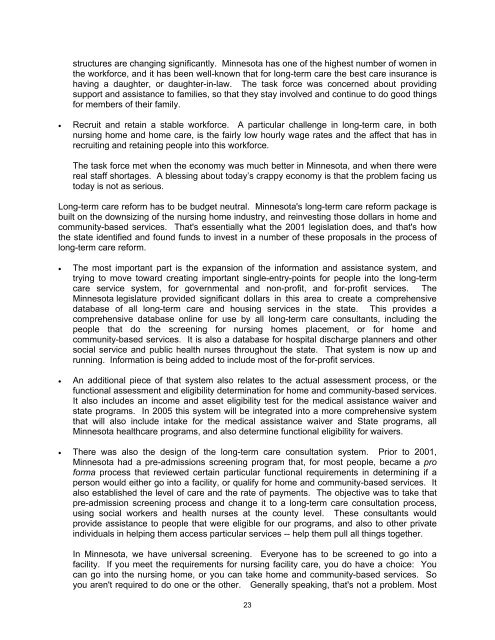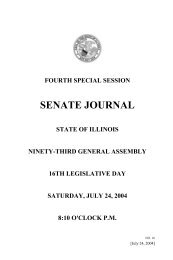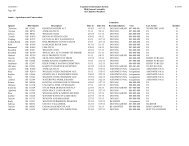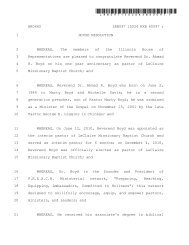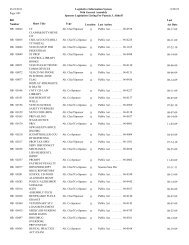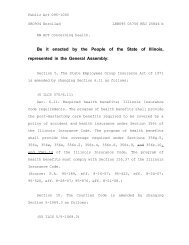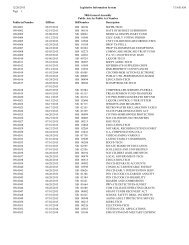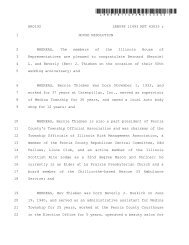Long-Term Care - Illinois General Assembly
Long-Term Care - Illinois General Assembly
Long-Term Care - Illinois General Assembly
You also want an ePaper? Increase the reach of your titles
YUMPU automatically turns print PDFs into web optimized ePapers that Google loves.
structures are changing significantly. Minnesota has one of the highest number of women in<br />
the workforce, and it has been well-known that for long-term care the best care insurance is<br />
having a daughter, or daughter-in-law. The task force was concerned about providing<br />
support and assistance to families, so that they stay involved and continue to do good things<br />
for members of their family.<br />
• Recruit and retain a stable workforce. A particular challenge in long-term care, in both<br />
nursing home and home care, is the fairly low hourly wage rates and the affect that has in<br />
recruiting and retaining people into this workforce.<br />
The task force met when the economy was much better in Minnesota, and when there were<br />
real staff shortages. A blessing about today’s crappy economy is that the problem facing us<br />
today is not as serious.<br />
<strong>Long</strong>-term care reform has to be budget neutral. Minnesota's long-term care reform package is<br />
built on the downsizing of the nursing home industry, and reinvesting those dollars in home and<br />
community-based services. That's essentially what the 2001 legislation does, and that's how<br />
the state identified and found funds to invest in a number of these proposals in the process of<br />
long-term care reform.<br />
• The most important part is the expansion of the information and assistance system, and<br />
trying to move toward creating important single-entry-points for people into the long-term<br />
care service system, for governmental and non-profit, and for-profit services. The<br />
Minnesota legislature provided significant dollars in this area to create a comprehensive<br />
database of all long-term care and housing services in the state. This provides a<br />
comprehensive database online for use by all long-term care consultants, including the<br />
people that do the screening for nursing homes placement, or for home and<br />
community-based services. It is also a database for hospital discharge planners and other<br />
social service and public health nurses throughout the state. That system is now up and<br />
running. Information is being added to include most of the for-profit services.<br />
• An additional piece of that system also relates to the actual assessment process, or the<br />
functional assessment and eligibility determination for home and community-based services.<br />
It also includes an income and asset eligibility test for the medical assistance waiver and<br />
state programs. In 2005 this system will be integrated into a more comprehensive system<br />
that will also include intake for the medical assistance waiver and State programs, all<br />
Minnesota healthcare programs, and also determine functional eligibility for waivers.<br />
• There was also the design of the long-term care consultation system. Prior to 2001,<br />
Minnesota had a pre-admissions screening program that, for most people, became a pro<br />
forma process that reviewed certain particular functional requirements in determining if a<br />
person would either go into a facility, or qualify for home and community-based services. It<br />
also established the level of care and the rate of payments. The objective was to take that<br />
pre-admission screening process and change it to a long-term care consultation process,<br />
using social workers and health nurses at the county level. These consultants would<br />
provide assistance to people that were eligible for our programs, and also to other private<br />
individuals in helping them access particular services -- help them pull all things together.<br />
In Minnesota, we have universal screening. Everyone has to be screened to go into a<br />
facility. If you meet the requirements for nursing facility care, you do have a choice: You<br />
can go into the nursing home, or you can take home and community-based services. So<br />
you aren't required to do one or the other. <strong>General</strong>ly speaking, that's not a problem. Most<br />
23


